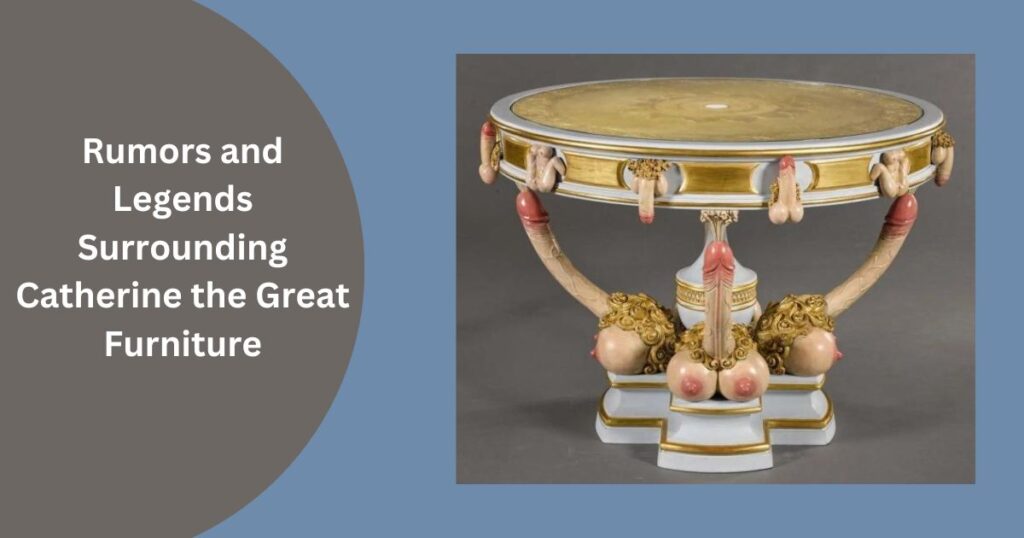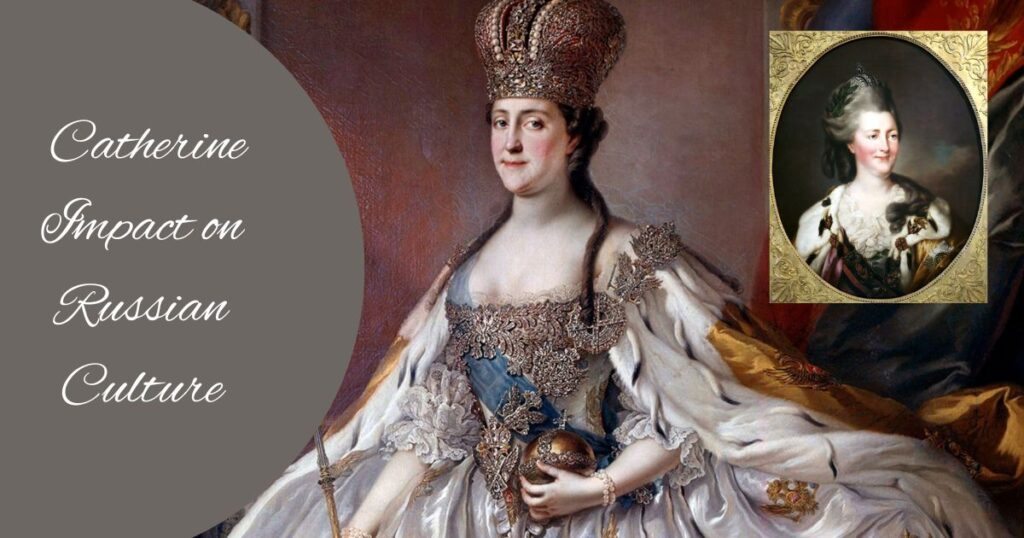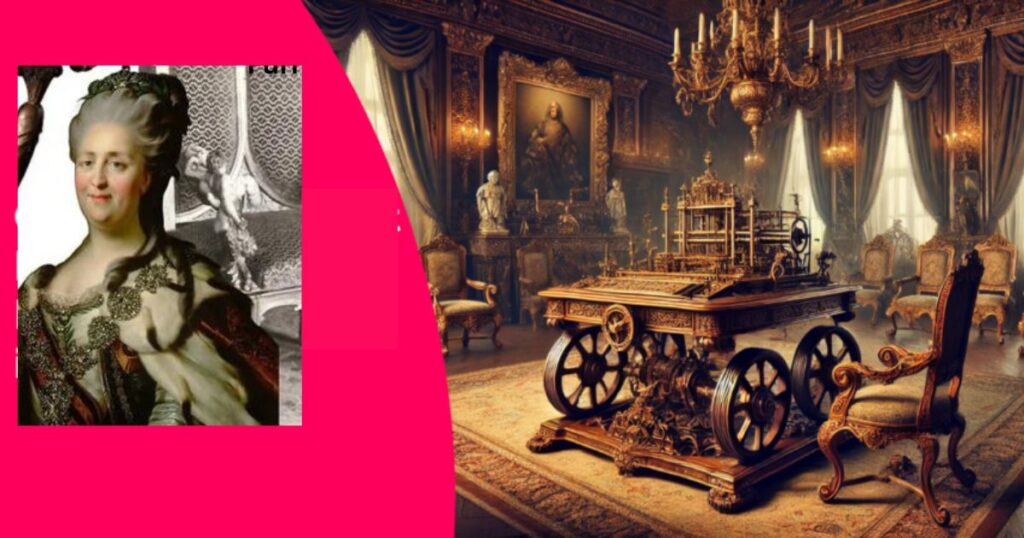In the glittering world of 18th-century Russian opulence, no collection of furniture has sparked more fascination than that of Catherine the Great, Empress of Russia.
From ingenious mechanical tables to whispered legends of secret rooms, these historical treasures weave a compelling narrative of power, innovation, and artistic brilliance in the Russian Empire.
Introduction to Catherine the Great and Her Era
The story begins with a remarkable transformation. Born Sophie Friederike Auguste von Anhalt-Zerbst in German territory, the future empress arrived in Russia as a teenage bride.
After orchestrating a successful coup against her husband Peter III in 1762, she emerged as Catherine II, later known as Catherine the Great. Her 34-year reign would revolutionize not just Russian politics, but the entire cultural landscape of the empire.
“I came to Russia as a modest German princess,” she once wrote to a French correspondent, “but Russia has remade me in its own image.” This transformation extended beyond personal reinvention – it manifested physically in the spaces she created, particularly in her remarkable furniture collection.
Influence of Catherine the Great on Furniture Design
Catherine’s vision for Russian furniture transcended mere decoration. She understood that furniture could serve as a powerful symbol of imperial might and cultural sophistication. Under her patronage, Russian furniture design experienced a renaissance that merged three distinct influences:
| Design Tradition | Key Contributions | Notable Features |
| Russian Classical | Imperial symbols, Orthodox motifs | Bold colors, religious imagery |
| French Rococo | Ornate details, curved lines | Gilt bronze, marquetry |
| English Georgian | Practical functionality | Solid construction, mahogany |
The empress particularly favored pieces that combined practicality with innovation. Her mechanical writing desk, now housed in the Hermitage Museum, exemplifies this approach. The desk contained hidden compartments for private correspondence while featuring an ingenious lifting mechanism that allowed it to serve multiple functions.
Rumors and Legends Surrounding Catherine the Great Furniture

The more scandalous tales about Catherine’s furniture collection emerged during her lifetime and gained momentum after her death. While many stories originated as political propaganda from her European rivals, they’ve become an inseparable part of her legacy.
Contemporary historians note that these legends often reveal more about 18th-century attitudes toward powerful women than historical reality.
Click For More information: The Real Greatness Net Worth: Latest Insights & Figures
The Mystery of the X-Rated Furniture
Historical records from Catherine’s time paint a more nuanced picture than popular legend suggests. While the empress appreciated artistic beauty in all forms, claims about extensive collections of erotic furniture appear to be largely exaggerated.
Professor Elena Mikhailova of the Russian State Historical Museum notes, “These stories say more about the imagination of Catherine’s critics than her actual furnishing choices.”
Catherine the Great’s Bedroom
The Imperial bedroom in the Winter Palace represented the pinnacle of 18th-century Russian luxury. French ambassador Count Louis-Philippe de Ségur described it as “a temple to both rest and stately power.”
The centerpiece was an enormous state bed, crafted by French master Jean-Baptiste Chardon, featuring intricate gilt bronze mounts and silk upholstery from Lyon.
Contemporary records detail the room’s remarkable features:
| Feature | Description | Historical Significance |
| State Bed | Gold-leafed canopy, silk hangings | Symbol of imperial authority |
| Wall Panels | Hand-painted Chinese silk | Demonstrated global trade connections |
| Mechanical Tables | Multi-functional bronze-mounted | Showcased technological innovation |
| Mirror Systems | Venetian glass with gilt frames | Reflected Western European influence |
The Revolutionary Mechanical Table

Among Catherine’s most innovative commissions was her mechanical table, representing the height of 18th-century engineering. This masterpiece, created by German craftsman Heinrich Gambs, incorporated multiple mechanisms allowing it to transform from a writing desk to a dining table. The table featured:
"The ingenuity of this piece lies not just in its mechanics, but in how it embodied Catherine's vision of Russia as a modern European power," notes furniture historian Dr. Michael Roberts.
Infamous Suite of Rooms
The legendary suite of rooms in the Winter Palace served multiple functions throughout Catherine’s reign. Court documents reveal these spaces housed her private art collection and personal library rather than the salacious contents suggested by later myths. The rooms featured specially commissioned furniture pieces designed to display artworks and protect valuable manuscripts.
Wehrmacht’s Discovery in 1941
The story took an unexpected turn during World War II when Nazi forces entered Soviet territory. Two Wehrmacht officers, Heinrich Mueller and Karl Schmidt, documented finding unusual furniture pieces in one of Catherine’s palaces. Their report, recently analyzed by historians, provides intriguing but inconclusive evidence about the nature of these discoveries.
Role of French Furniture Makers
French artisans profoundly influenced Catherine’s collection. Master craftsmen like Jean-Baptiste Chardon and David Roentgen brought sophisticated techniques to the Russian court. They introduced:
"The marriage of French craftsmanship with Russian materials created something entirely new," wrote Catherine to Voltaire in 1772, highlighting her appreciation for this cultural fusion.
Impact on Russian Culture

The influence of Catherine’s furniture collection extended far beyond her lifetime. Her design principles shaped Russian aristocratic taste well into the 19th century. Modern-day connections to this legacy can be found in both the British royal family and Danish royal house, where certain decorative traditions trace back to Catherine’s era.
Click for More Information: Inside Riley Reid Relationships: Actress & Model’s Love Story
Conclusion
The story of Catherine the Great’s furniture represents more than just a collection of historical pieces – it embodies the cultural and political ambitions of an extraordinary ruler. From mechanical innovations to artistic excellence, these pieces continue to captivate furniture enthusiasts and historians alike.
FAQ’s Section
What exactly was Catherine the Great furniture?
Catherine the Great’s furniture encompassed a wide range of pieces combining Russian craftsmanship with French elegance. The collection included innovative mechanical furniture, state beds, decorative tables, and ceremonial chairs, all reflecting the highest standards of 18th-century design and craftsmanship.
What made Catherine the Great famous beyond her furniture collection?
Catherine transformed Russia into a European powerhouse through extensive reforms, territorial expansion, and cultural patronage. Her reign marked Russia’s Golden Age, with achievements in education, law, and the arts.
How can we trace living descendants of Catherine the Great?
Catherine’s bloodline continues through European royal families, including the British royal family and Danish royal house. Queen Victoria’s granddaughter married into the Russian royal family, creating lasting connections between these royal houses.
What role did Grigory Potemkin play in Catherine’s furniture collection?
As Catherine’s closest advisor and companion, Potemkin helped shape her artistic vision and often supervised the acquisition of important pieces. Their partnership influenced both political decisions and cultural developments in the Russian Empire.
Key Takeaways
Looking back at Catherine the Great’s furniture legacy reveals several crucial points:
- Her collection represented unprecedented fusion of Russian and French designs
- Mechanical innovations in her furniture predicted modern functionality
- Legends about her furniture often reflected political agendas
- French craftsmen revolutionized Russian furniture design
- Her influence continues in modern European royal collections
The enduring fascination with Catherine the Great’s furniture speaks to both its historical significance and timeless appeal. These pieces remain powerful symbols of an era when Russian culture embraced innovation while maintaining its unique character.
